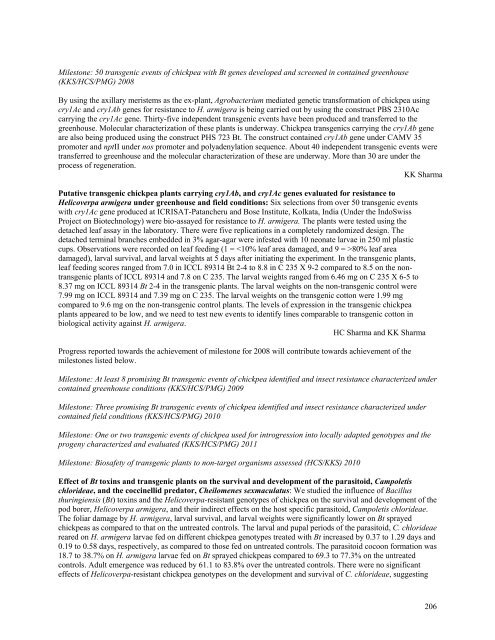ICRISAT Archival Report 2006 - The seedlings of success in the ...
ICRISAT Archival Report 2006 - The seedlings of success in the ...
ICRISAT Archival Report 2006 - The seedlings of success in the ...
You also want an ePaper? Increase the reach of your titles
YUMPU automatically turns print PDFs into web optimized ePapers that Google loves.
Milestone: 50 transgenic events <strong>of</strong> chickpea with Bt genes developed and screened <strong>in</strong> conta<strong>in</strong>ed greenhouse<br />
(KKS/HCS/PMG) 2008<br />
By us<strong>in</strong>g <strong>the</strong> axillary meristems as <strong>the</strong> ex-plant, Agrobacterium mediated genetic transformation <strong>of</strong> chickpea us<strong>in</strong>g<br />
cry1Ac and cry1Ab genes for resistance to H. armigera is be<strong>in</strong>g carried out by us<strong>in</strong>g <strong>the</strong> construct PBS 2310Ac<br />
carry<strong>in</strong>g <strong>the</strong> cry1Ac gene. Thirty-five <strong>in</strong>dependent transgenic events have been produced and transferred to <strong>the</strong><br />
greenhouse. Molecular characterization <strong>of</strong> <strong>the</strong>se plants is underway. Chickpea transgenics carry<strong>in</strong>g <strong>the</strong> cry1Ab gene<br />
are also be<strong>in</strong>g produced us<strong>in</strong>g <strong>the</strong> construct PHS 723 Bt. <strong>The</strong> construct conta<strong>in</strong>ed cry1Ab gene under CAMV 35<br />
promoter and nptII under nos promoter and polyadenylation sequence. About 40 <strong>in</strong>dependent transgenic events were<br />
transferred to greenhouse and <strong>the</strong> molecular characterization <strong>of</strong> <strong>the</strong>se are underway. More than 30 are under <strong>the</strong><br />
process <strong>of</strong> regeneration.<br />
KK Sharma<br />
Putative transgenic chickpea plants carry<strong>in</strong>g cry1Ab, and cry1Ac genes evaluated for resistance to<br />
Helicoverpa armigera under greenhouse and field conditions: Six selections from over 50 transgenic events<br />
with cry1Ac gene produced at <strong>ICRISAT</strong>-Patancheru and Bose Institute, Kolkata, India (Under <strong>the</strong> IndoSwiss<br />
Project on Biotechnology) were bio-assayed for resistance to H. armigera. <strong>The</strong> plants were tested us<strong>in</strong>g <strong>the</strong><br />
detached leaf assay <strong>in</strong> <strong>the</strong> laboratory. <strong>The</strong>re were five replications <strong>in</strong> a completely randomized design. <strong>The</strong><br />
detached term<strong>in</strong>al branches embedded <strong>in</strong> 3% agar-agar were <strong>in</strong>fested with 10 neonate larvae <strong>in</strong> 250 ml plastic<br />
cups. Observations were recorded on leaf feed<strong>in</strong>g (1 = 80% leaf area<br />
damaged), larval survival, and larval weights at 5 days after <strong>in</strong>itiat<strong>in</strong>g <strong>the</strong> experiment. In <strong>the</strong> transgenic plants,<br />
leaf feed<strong>in</strong>g scores ranged from 7.0 <strong>in</strong> ICCL 89314 Bt 2-4 to 8.8 <strong>in</strong> C 235 X 9-2 compared to 8.5 on <strong>the</strong> nontransgenic<br />
plants <strong>of</strong> ICCL 89314 and 7.8 on C 235. <strong>The</strong> larval weights ranged from 6.46 mg on C 235 X 6-5 to<br />
8.37 mg on ICCL 89314 Bt 2-4 <strong>in</strong> <strong>the</strong> transgenic plants. <strong>The</strong> larval weights on <strong>the</strong> non-transgenic control were<br />
7.99 mg on ICCL 89314 and 7.39 mg on C 235. <strong>The</strong> larval weights on <strong>the</strong> transgenic cotton were 1.99 mg<br />
compared to 9.6 mg on <strong>the</strong> non-transgenic control plants. <strong>The</strong> levels <strong>of</strong> expression <strong>in</strong> <strong>the</strong> transgenic chickpea<br />
plants appeared to be low, and we need to test new events to identify l<strong>in</strong>es comparable to transgenic cotton <strong>in</strong><br />
biological activity aga<strong>in</strong>st H. armigera.<br />
HC Sharma and KK Sharma<br />
Progress reported towards <strong>the</strong> achievement <strong>of</strong> milestone for 2008 will contribute towards achievement <strong>of</strong> <strong>the</strong><br />
milestones listed below.<br />
Milestone: At least 8 promis<strong>in</strong>g Bt transgenic events <strong>of</strong> chickpea identified and <strong>in</strong>sect resistance characterized under<br />
conta<strong>in</strong>ed greenhouse conditions (KKS/HCS/PMG) 2009<br />
Milestone: Three promis<strong>in</strong>g Bt transgenic events <strong>of</strong> chickpea identified and <strong>in</strong>sect resistance characterized under<br />
conta<strong>in</strong>ed field conditions (KKS/HCS/PMG) 2010<br />
Milestone: One or two transgenic events <strong>of</strong> chickpea used for <strong>in</strong>trogression <strong>in</strong>to locally adapted genotypes and <strong>the</strong><br />
progeny characterized and evaluated (KKS/HCS/PMG) 2011<br />
Milestone: Biosafety <strong>of</strong> transgenic plants to non-target organisms assessed (HCS/KKS) 2010<br />
Effect <strong>of</strong> Bt tox<strong>in</strong>s and transgenic plants on <strong>the</strong> survival and development <strong>of</strong> <strong>the</strong> parasitoid, Campoletis<br />
chlorideae, and <strong>the</strong> cocc<strong>in</strong>ellid predator, Cheilomenes sexmaculatus: We studied <strong>the</strong> <strong>in</strong>fluence <strong>of</strong> Bacillus<br />
thur<strong>in</strong>giensis (Bt) tox<strong>in</strong>s and <strong>the</strong> Helicoverpa-resistant genotypes <strong>of</strong> chickpea on <strong>the</strong> survival and development <strong>of</strong> <strong>the</strong><br />
pod borer, Helicoverpa armigera, and <strong>the</strong>ir <strong>in</strong>direct effects on <strong>the</strong> host specific parasitoid, Campoletis chlorideae.<br />
<strong>The</strong> foliar damage by H. armigera, larval survival, and larval weights were significantly lower on Bt sprayed<br />
chickpeas as compared to that on <strong>the</strong> untreated controls. <strong>The</strong> larval and pupal periods <strong>of</strong> <strong>the</strong> parasitoid, C. chlorideae<br />
reared on H. armigera larvae fed on different chickpea genotypes treated with Bt <strong>in</strong>creased by 0.37 to 1.29 days and<br />
0.19 to 0.58 days, respectively, as compared to those fed on untreated controls. <strong>The</strong> parasitoid cocoon formation was<br />
18.7 to 38.7% on H. armigera larvae fed on Bt sprayed chickpeas compared to 69.3 to 77.3% on <strong>the</strong> untreated<br />
controls. Adult emergence was reduced by 61.1 to 83.8% over <strong>the</strong> untreated controls. <strong>The</strong>re were no significant<br />
effects <strong>of</strong> Helicoverpa-resistant chickpea genotypes on <strong>the</strong> development and survival <strong>of</strong> C. chlorideae, suggest<strong>in</strong>g<br />
206

















